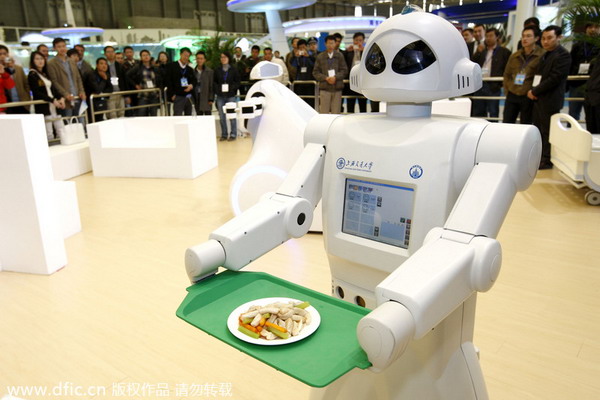|
 Visitors look at a robot performance during the China International Industry Fair 2009 in Shanghai. The "made-in-China" label has been shedding its cheap image and reputation for low value-added goods as China takes over the United States to become the top powerhouse in global trade. [File photo / dfic.cn] |
BEIJING - The "made-in-China" label has been shedding its cheap image and reputation for low value-added goods as China takes over the United States to become the top powerhouse in global trade.
Factories in the world's second-largest economy are churning out ever more sophisticated products for people around the globe, the latest customs statistics showed.
Machinery, electrical and high-tech products continued to expand their share of total exports with their growth rates outpacing those of other major items. In 2013, machinery, electrical and high-tech goods accounted for about 80 percent of total exports, contrary to perceptions that textiles, shoes and furniture make up the bulk of made-in-China goods.
Rising labor costs and yuan appreciation have propelled exporters to use money accumulated from decades of hard work to move up the production chain.
The upgrade accelerated amid a lukewarm global recovery evidenced by the latest disappointing hiring numbers in the United States. In 2013, China's exports rose 7.9 percent to $2.21 trillion.
China still has to make 100 million T-shirts to trade for one airplane. Meanwhile, Premier Li Keqiang has promoted advanced high-speed rail with Chinese-owned intellectual property during his foreign visits.
China operates 12,000 kilometers of high-speed railway - more than half of the world's total.
Employment trends underscore changes in industrial structure, according to a research note written by Louis Kuijs, China economist of the Royal Bank of Scotland.
In 2012, people working in transportation, electronics, computers, communication, machinery and equipment industries outnumbered those in textiles, apparel and leather by about four million, according to the research. In 2000, the latter industries employed almost twice as many workers than the former.
The domestic value-added component of exports is rising. The share of value added in exports rose from 63 percent in 2004 to 76 percent in 2012, Kuijs said.
China must rely on scientific and technological innovation to improve the overall quality of its economy and to move upward in the industrial value chain, Li said in a ceremony honoring scientists Friday.
